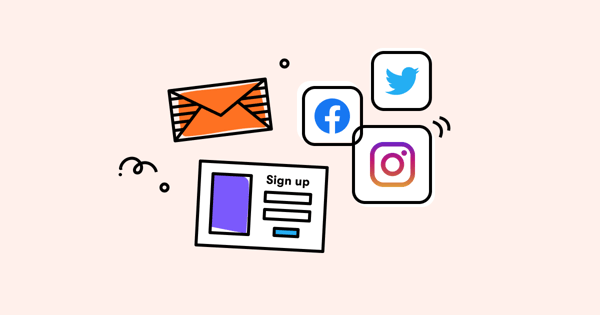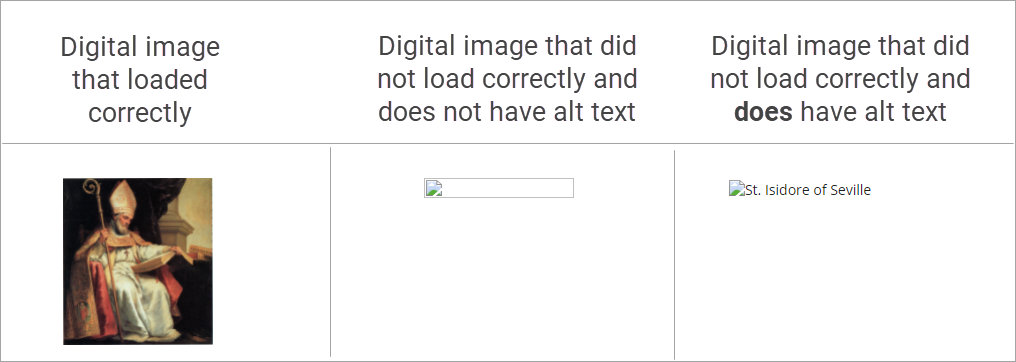Outbound marketing is like playing high-stakes darts. You throw one dart into a pool of dartboards, and hope that you make at least one bullseye.
While that’s well and good, if the only strategy you’re relying on is akin to shooting in the dark, you’re going to have a bad time.
That’s where inbound marketing comes in. Inbound marketing functions on providing real value to your potential customers, in the hopes that they’ll convert once they’re ready to buy.
Really, the problem is getting inbound marketing right. And a lot of ecommerce stores just aren’t.
In this piece, we’ll get into exactly what inbound marketing means, and what you need to get started.
Let’s dive deeper into inbound marketing.

What is Inbound Marketing?
Inbound marketing is a set of marketing techniques and strategies based in content creation. The idea is that you create content that’s relevant to your target customers, and use that to bring those high-intent customers to your store.
Imagine this: You’re in the market for a new pair of running shoes and searching online for options but can’t seem to find any you like.
A couple of days later, you look up “best running shoes” and come across an article titled “The 10 Best Running Shoes for 2023.” You begin looking through the blog, and you find a pair that looks to be in your price range and style preferences.
You go onto the site and begin reading reviews from happy customers that confirm your general feeling about the shoes. .
You add them to your cart and place an order for the shoes.
A few days later, your shoes arrive, and they’re everything you had hoped they’d be. The company even included a 15% off coupon for your next purchase.
Simply put, that's how inbound marketing works.
This scenario captures the four-step inbound marketing process: to attract, convert, close, and delight.
Inbound marketing involves posting relevant content on your website and other online platforms that garner interest in your product.
This introduces potential customers to your brand, who you then have to convert to paying customers.
While outbound marketing focuses on reaching out to potential customers to get them to make a purchase. Inbound marketing uses high-quality content to attract and retain customers for your ecommerce store.
And while inbound marketing is far from a new strategy — it’s still very much top-of-mind for many marketers. According to Hubspot’s State of Inbound Marketing Trends, inbound marketing was the top emerging trend for 2022.
4 Key Elements Of Inbound Marketing For Ecommerce
1. Buyer Personas:
Before you launch your marketing strategies, you’ll need to map out your target audience properly. This way, you don't send generic ads to all your customers.
Instead, you can split up your audience into different categories based on demographics like;
- Age
- Geographic location
- Gender
- Nationality
- Employment status
- Education
These specific categories represent a personality that reflects each target audience.
This personality is called a buyer's persona.
A buyer's persona breaks down your audience on a critical level helping you understand the wants and needs of that particular group.
You can also improve your grouping by considering buyers intent, asking questions like;
- Is this a new buyer?
- What is their purchase frequency?
- And how much do they spend?
Identifying a buyer's recency, frequency, and how much they can spend gives you a better insight into their customer value.
But how do you get the information you need?
One sure-fire easy-to-use method to get customer demographics is through Google analytics 4 (GA4).
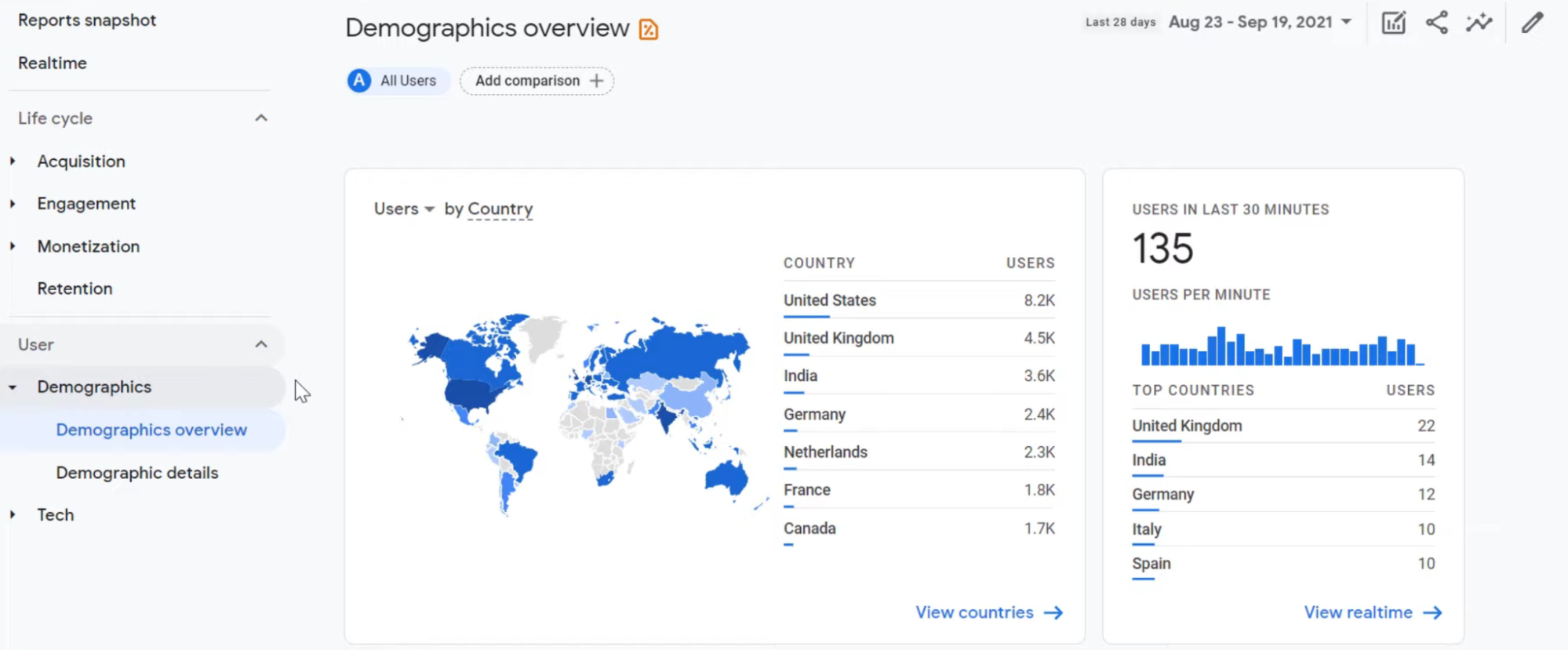 GA4 provides you with a demographic overview which you can use to create multiple buyer personas by breaking down demographics.
GA4 provides you with a demographic overview which you can use to create multiple buyer personas by breaking down demographics.
These buyer personas can then be used effectively to create personalized content for a specific audience to improve its effectiveness.
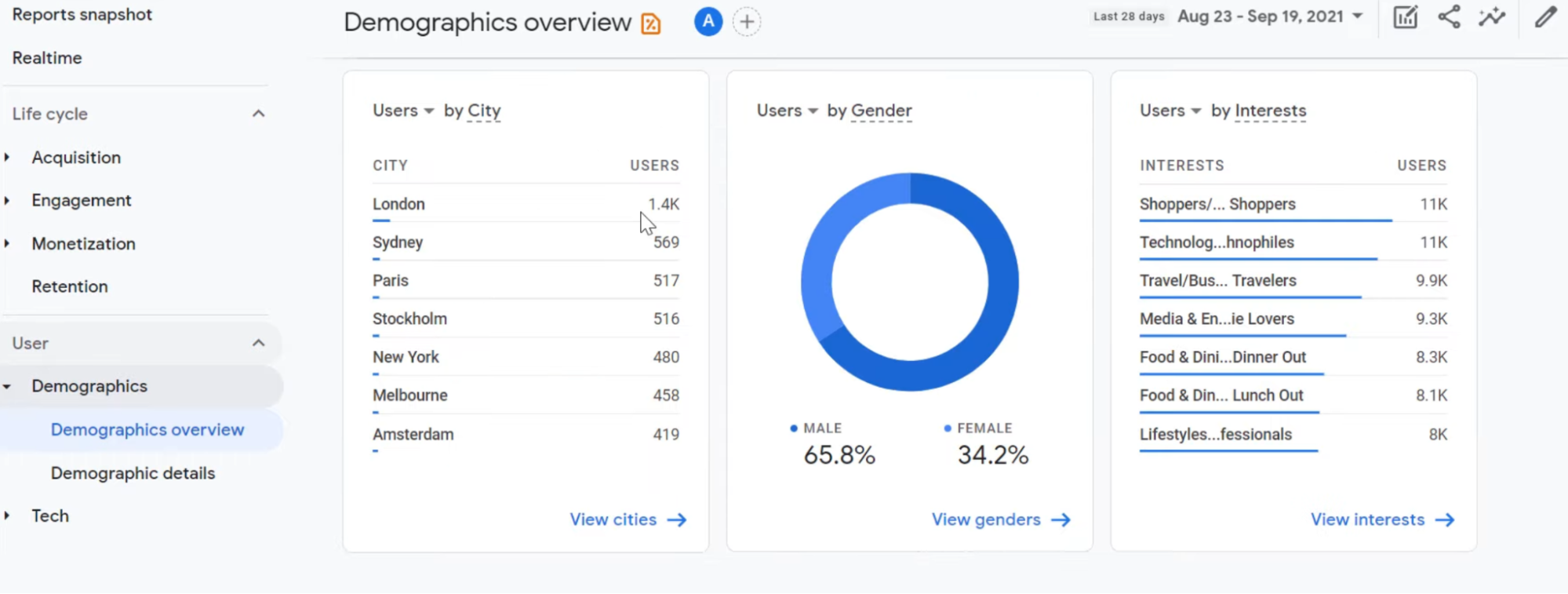 Personalized content can take different forms, from the subject line of your email to using language your audience will be familiar with.
Personalized content can take different forms, from the subject line of your email to using language your audience will be familiar with.
A great example is the BarkBox graphic below.
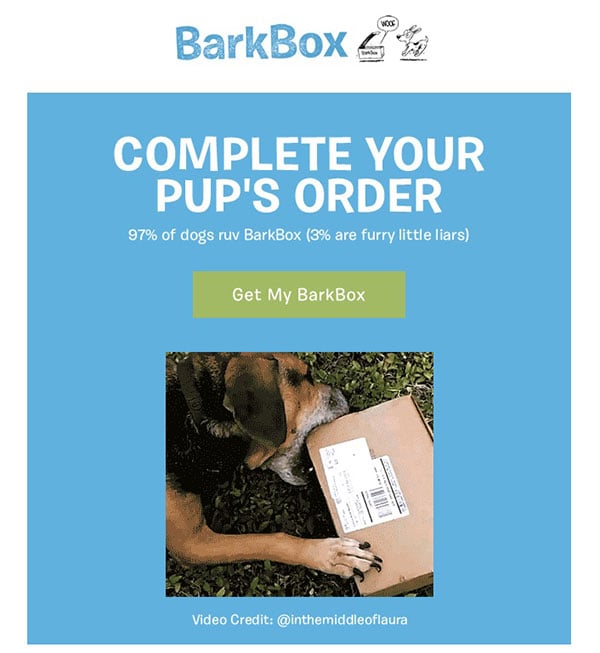 The call to action in the ad reads, “Complete Your Pup’s Order.”
The call to action in the ad reads, “Complete Your Pup’s Order.”
BarkBox uses “Pup’s” instead of “your” because they believe humanizing your pet will resonate better with their target buyer persona.
For example, people who love their dogs want them to be happy — and showing a satisfied customer (this handsome pup) alongside the perspective of your customer’s furry friend is a great way to connect with them emotionally.
Another example from BarkBox is the subject line of their email.
![]() Once again, BarkBox uses a personalized subject line they believe will resonate well with BarkBox customers.
Once again, BarkBox uses a personalized subject line they believe will resonate well with BarkBox customers.
2. Content Marketing
As I said previously, a huge part of inbound marketing is using high-quality content to attract customers.
Content marketing for ecommerce is creating valuable content, including blog posts and videos filled with helpful information about that industry.
This valuable content builds a connection between a customer's interests and your products or service, which you can convert into sales.
For instance, let’s look at Northern Brewer’s content strategy.
Northern Brewer is an ecommerce brand offering recipe kits, home brewing starter kits, equipment, and ingredients to individuals getting into microbrewing.
Microbrewery has experienced a recent boom in interest, forming the basis of Northern Brewer's content strategy.
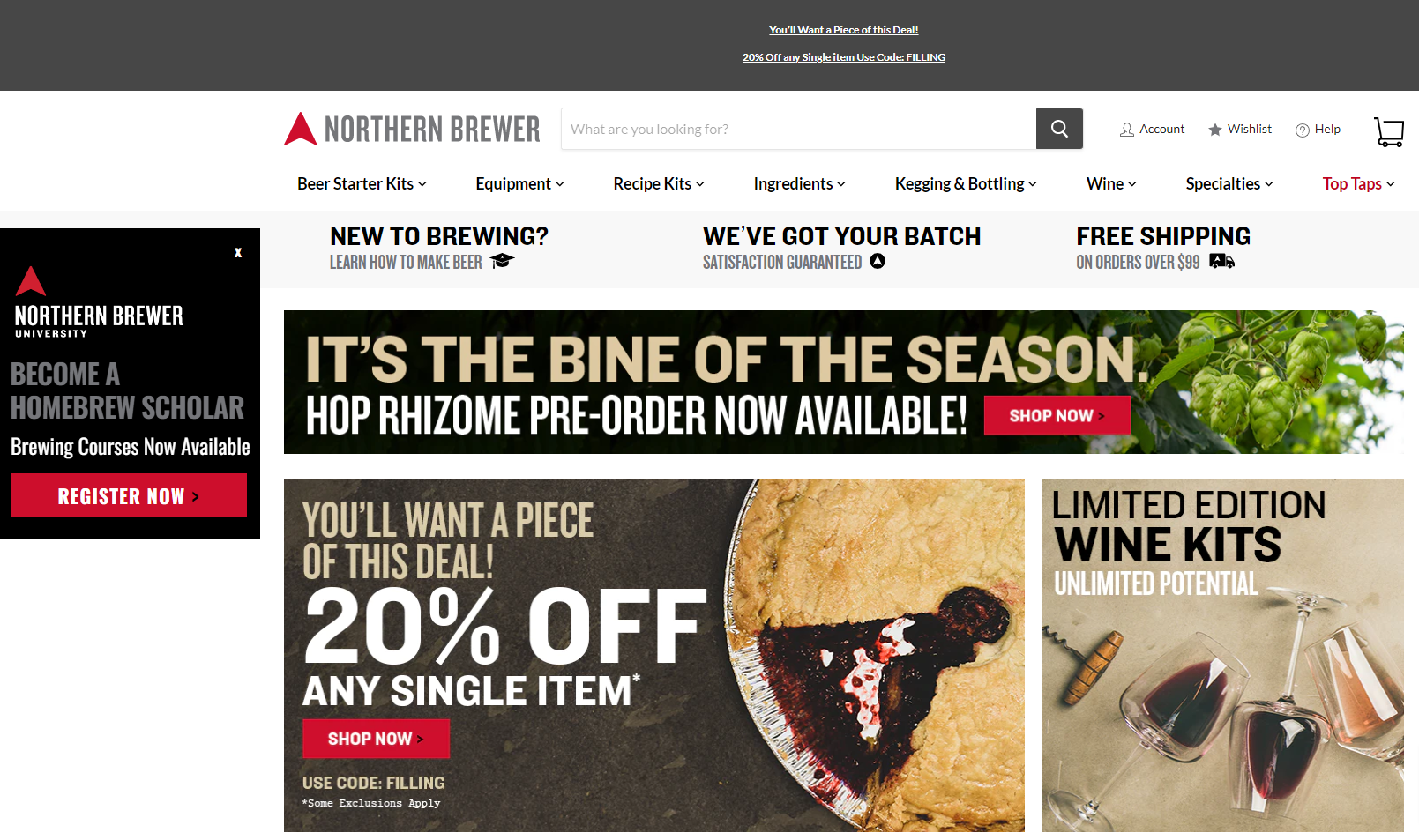 Even from the home page, Northern Brewer offers brewing courses in a slide-in popup that appears as you land on the page. That offer is clear for someone looking into brewing their beer at home as soon as they arrive on the site.
Even from the home page, Northern Brewer offers brewing courses in a slide-in popup that appears as you land on the page. That offer is clear for someone looking into brewing their beer at home as soon as they arrive on the site.
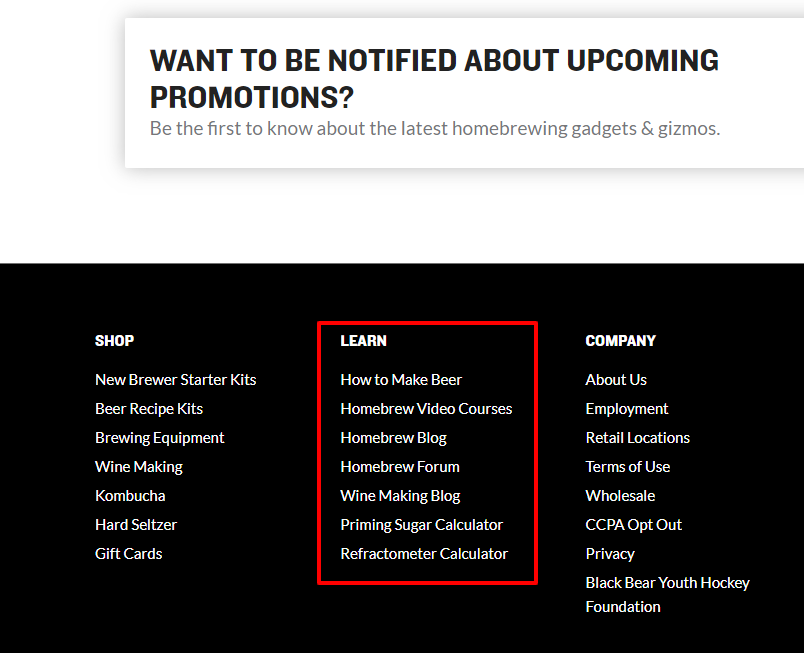 The inbound marketing strategy is clear: Northern Brewer offers expertise in brewing your beer at home, plus everything you need to get started. The authority they build in offering those courses and information makes their customers view them as experts in the field.
The inbound marketing strategy is clear: Northern Brewer offers expertise in brewing your beer at home, plus everything you need to get started. The authority they build in offering those courses and information makes their customers view them as experts in the field.
After all, why go elsewhere when I can get the information I need and everything to make it happen in one place?
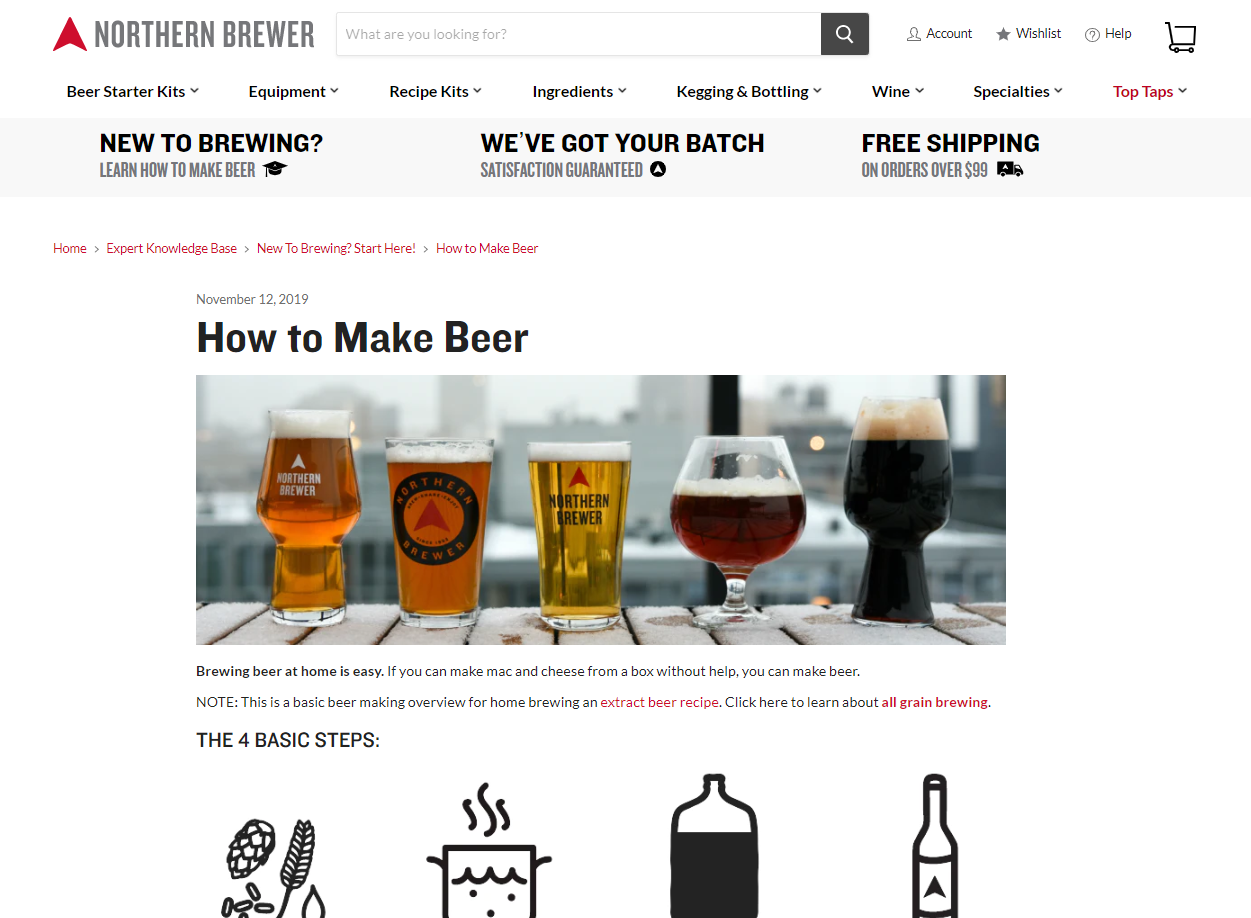 In addition, Northern Brewer finds a way to weave its products into these info pages. So as a customer gets the education they need, they also find relevant products that can help in their home brewing journey.
In addition, Northern Brewer finds a way to weave its products into these info pages. So as a customer gets the education they need, they also find relevant products that can help in their home brewing journey.
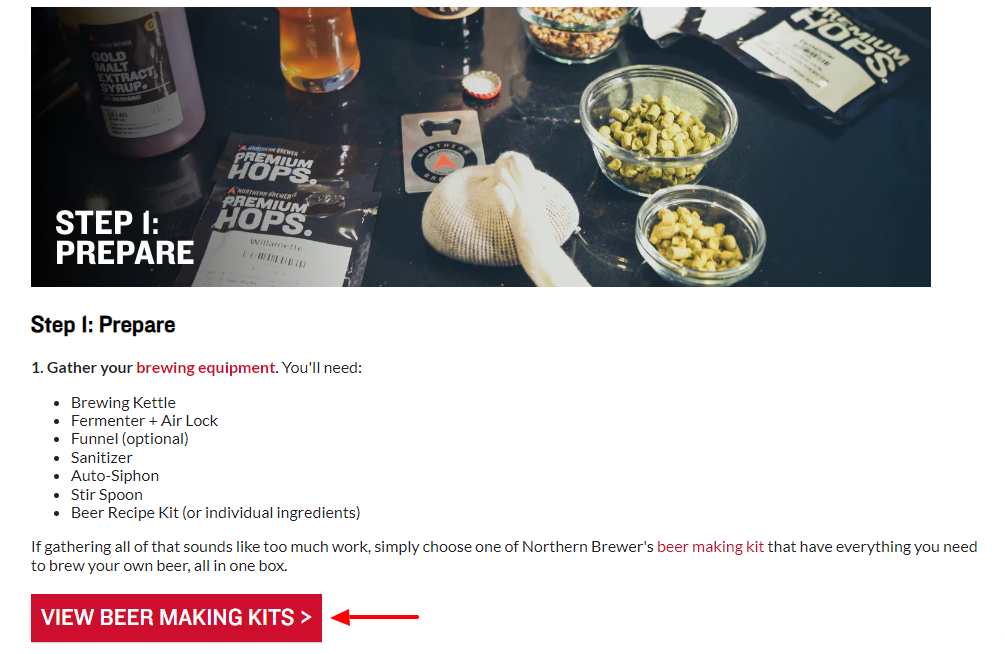 When a customer clicks on a link, they get directed to the product page, but it doesn’t end there.
When a customer clicks on a link, they get directed to the product page, but it doesn’t end there.
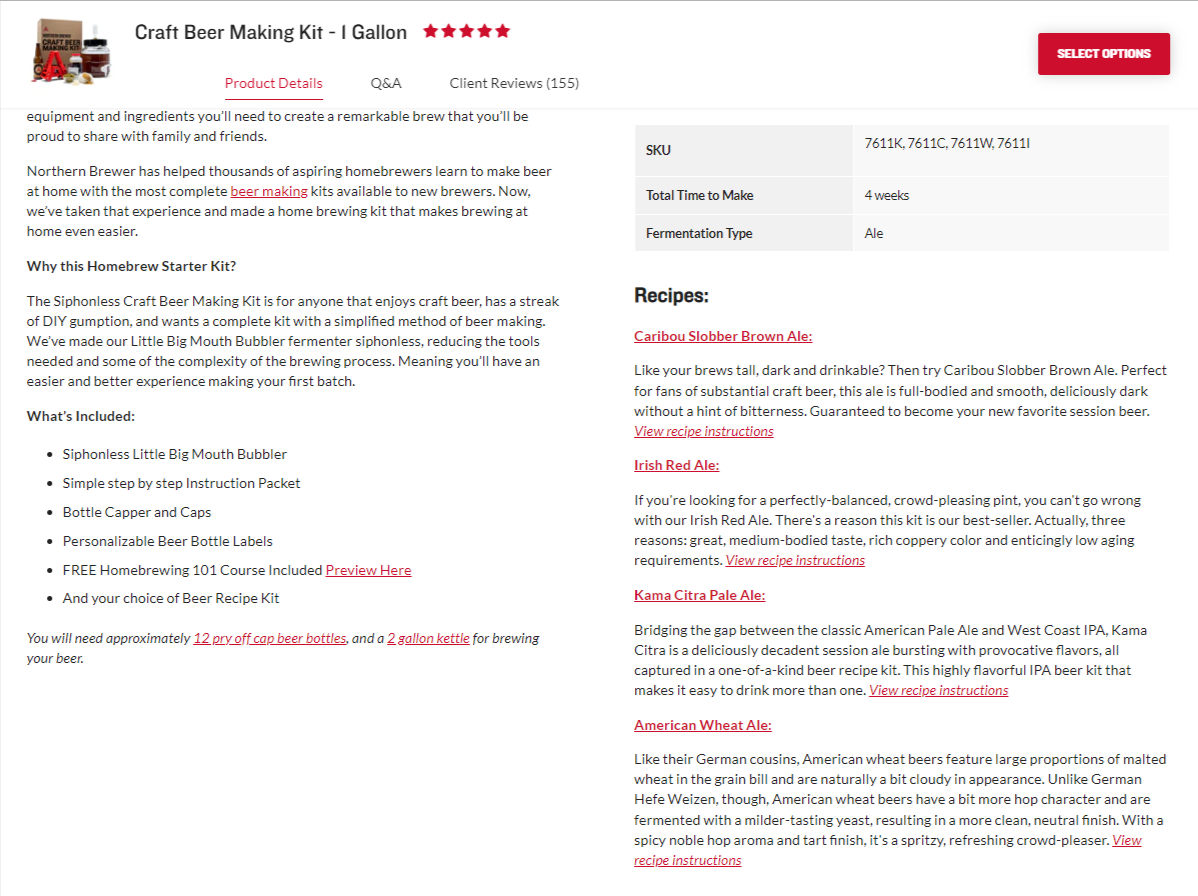 Not only does Northern Brewer offer a detailed product description, but right alongside it are recipes their customers can try out as soon as they get their kit. This isn’t just an SEO opportunity (although it’s a fantastic way to build an SEO-friendly product page) but also helps earn their customers’ trust.
Not only does Northern Brewer offer a detailed product description, but right alongside it are recipes their customers can try out as soon as they get their kit. This isn’t just an SEO opportunity (although it’s a fantastic way to build an SEO-friendly product page) but also helps earn their customers’ trust.
Northern Brewer has understood that if their customers are successful during their first brew, it will reinforce their trust in the brand.
And they’ll be back for more.
Northern Brewer’s content strategy takes it a step further by introducing their customers' content to amplify that trust factor.
So if their customer didn’t already think Northern Brewer was an authority in the home-brewing space, tons of other happy customers are ready to testify.
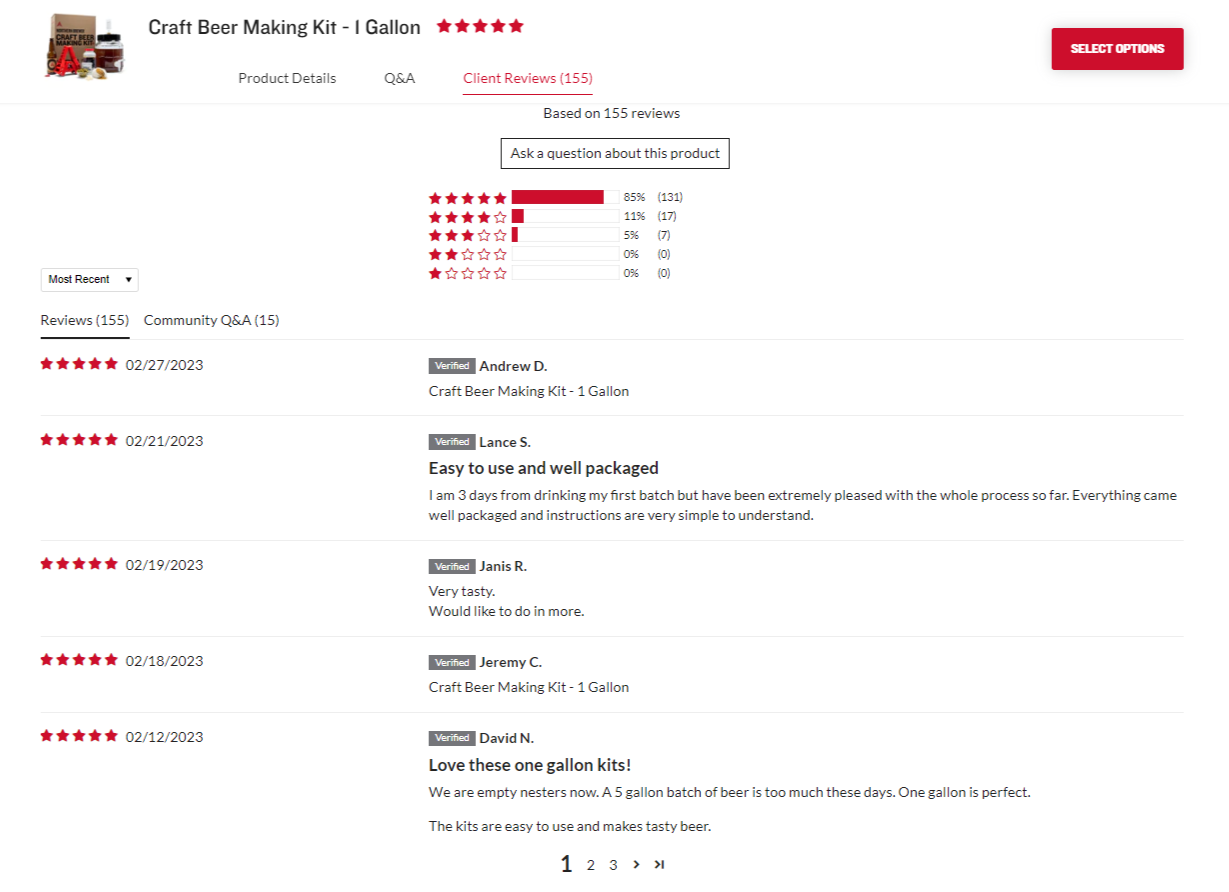 Northern Brewer also has a video library with step-by-step instructions from experts and forums where customers can interact with other microbrewing enthusiasts. Those forums create a sense of community around their store and products and provide another resource to those learning how to brew.
Northern Brewer also has a video library with step-by-step instructions from experts and forums where customers can interact with other microbrewing enthusiasts. Those forums create a sense of community around their store and products and provide another resource to those learning how to brew.
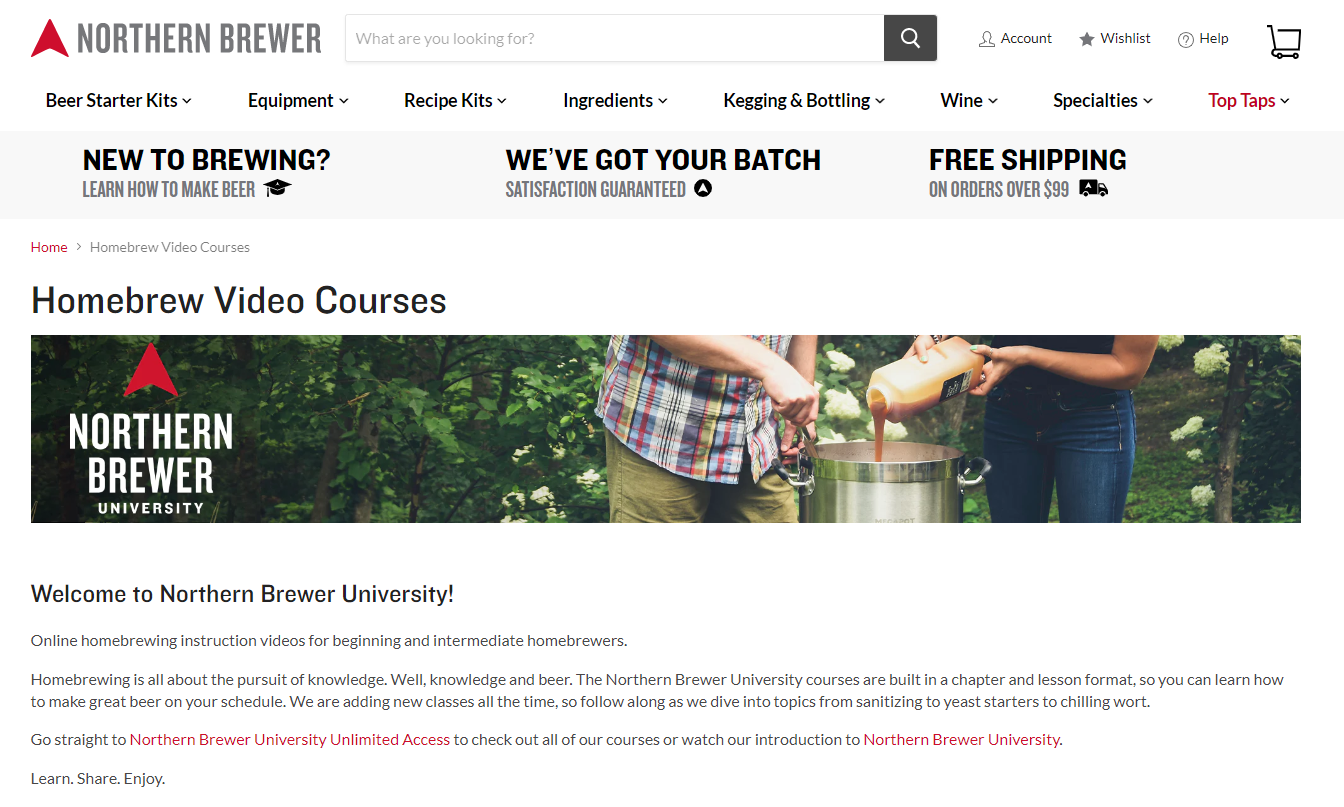 Northern Brewer’s fascinating strategy of using customer education as a content play can also work for your ecommerce brand, depending on your niche.
Northern Brewer’s fascinating strategy of using customer education as a content play can also work for your ecommerce brand, depending on your niche.
3. Search Engine Optimization
Search Engine Optimization or SEO is a key element of ecommerce inbound marketing.
The SEO for your ecommerce website helps you rank on the first page of search engines and boosts your brand visibility.
So how does it work?
Search engines don’t see websites the way people do.
Google has crawlers, known as “spiders” in the industry, that crawl a site’s text and HTML, looking at what's known as structured data: reviews, alt texts on images, titles, and keywords in site copy.
Google uses that data to determine whether a site responds to its user’s search intent. It’s not enough to hit the keyword itself. Google wants to ensure it has adequately answered its user’s questions.
The easiest way to help Google recognize that you answer their user’s questions is by structuring your site in a way that makes Google’s job easier.
This means that your site’s structure should be simple and easy to use, with a UX that doesn’t make a potential customer leave after just a few seconds.
Let's consider the ecommerce store OLIPOP’s site structure.
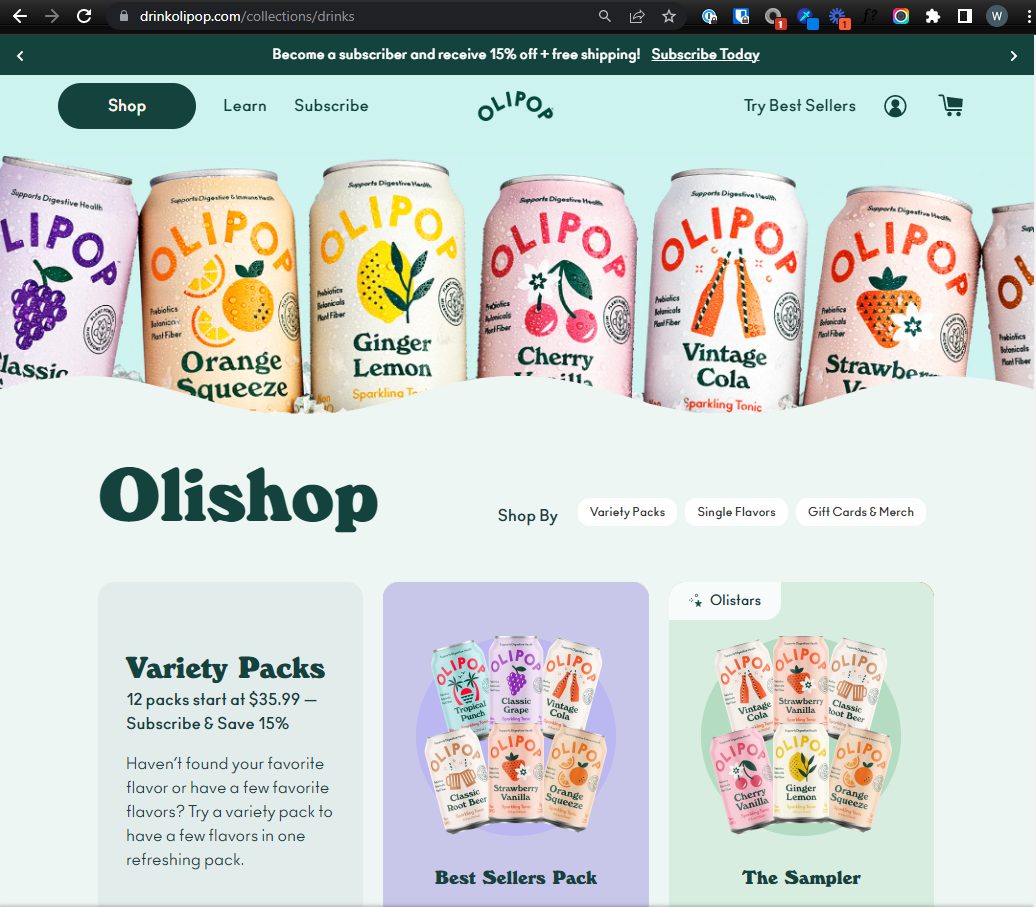 Clicking the main CTA (call-to-action) from the home page leads you to a clear category page with the various things their customers can buy. Even their URL structure: “/collections/drinks” is clear to both the user and Google.
Clicking the main CTA (call-to-action) from the home page leads you to a clear category page with the various things their customers can buy. Even their URL structure: “/collections/drinks” is clear to both the user and Google.
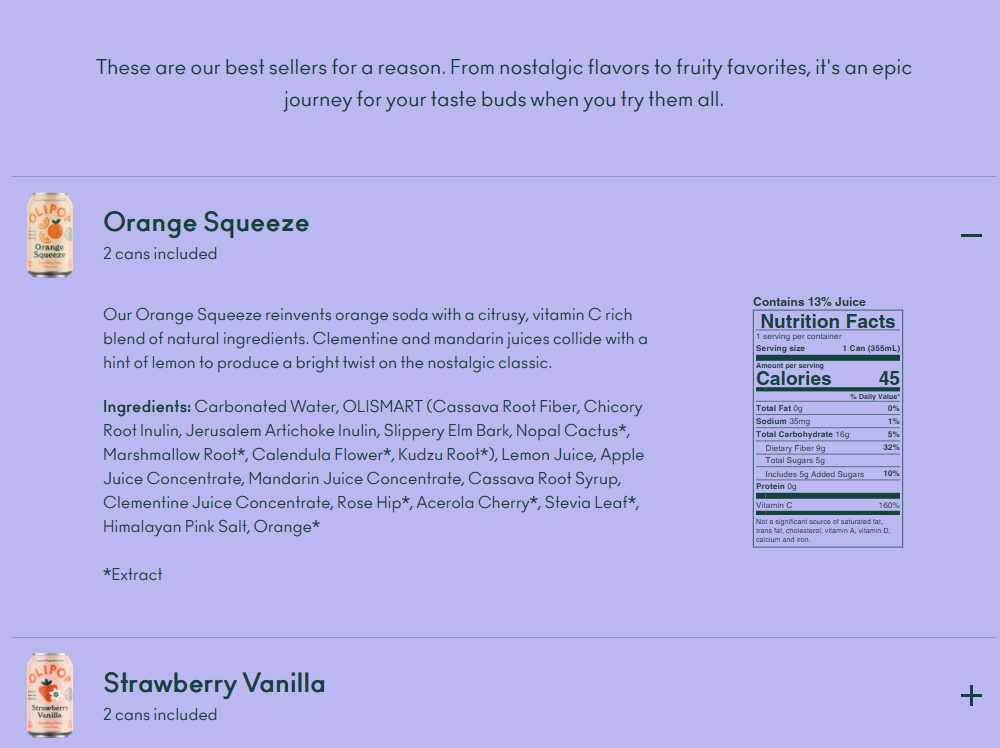 Upon clicking the “Try best Sellers” option, you are directed to another page with all the options listed along with their prices, ingredients, and reviews. These reviews not only help them build trust with the customer that lands on that page, but it also helps them provide enough content to be crawlable by Google.
Upon clicking the “Try best Sellers” option, you are directed to another page with all the options listed along with their prices, ingredients, and reviews. These reviews not only help them build trust with the customer that lands on that page, but it also helps them provide enough content to be crawlable by Google.
Which helps them rank for the keyword OLIPOP reviews.
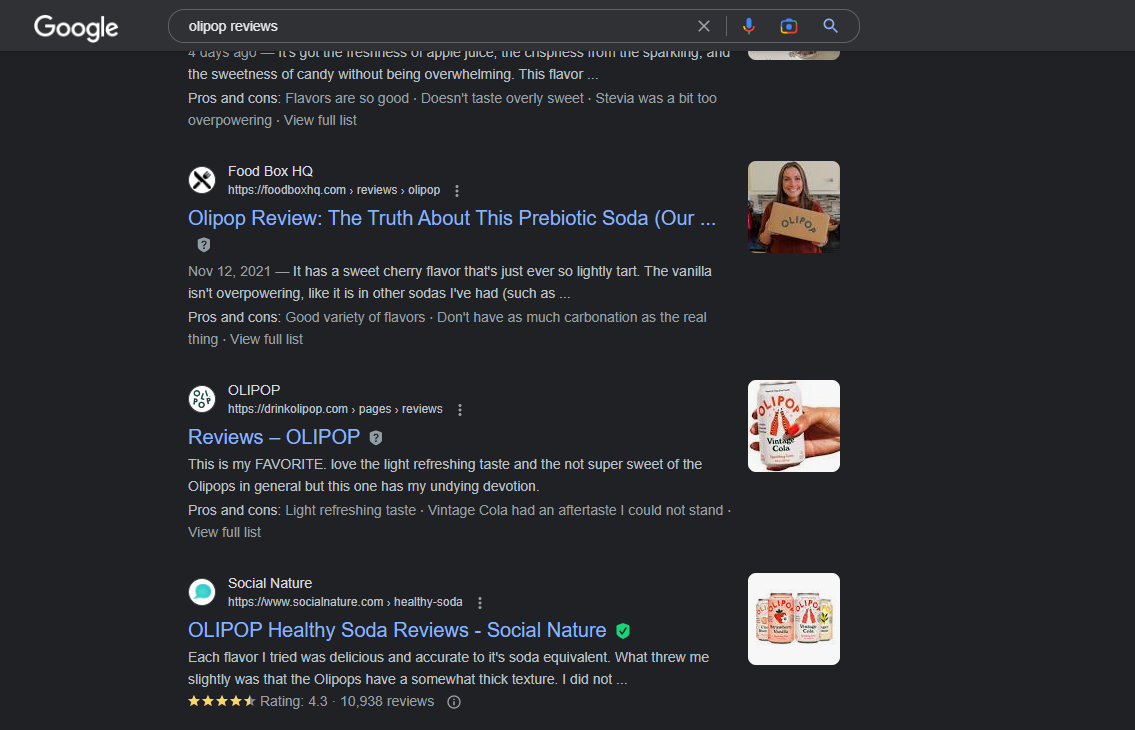
The simplicity and organized structure also make it easy for customers to find your products and for Google to index your website pages, improving your brand visibility.
Why is user experience so important for SEO? Not only does Google measure how easy it is to navigate your site — it also measures how long someone spends on your site. This means that if a customer comes to your site and leaves within ten seconds, Google assumes that your site wasn’t the answer to the question they had. This will tell Google that your site isn’t right for a particular keyword.
If that keyword happens to be “interesting soda choices” for example, that’s bad news for you.
However, as long as you keep a clear, easy-to-use UX for your customers, you’ll help Google understand that your site does respond to the question they’ve asked.
There are other aspects that you can focus on to improve your SEO. This can include keyword research, meta description, and alt text, to name a few. Let’s go into detail for each of these to understand their implications better.
Keyword Research
Keyword research essentially means to find and analyze search queries that people type to look for specific products or services.
For example, if you were to Google “what is the healthiest soda?” OLIPOP would be on the first page:
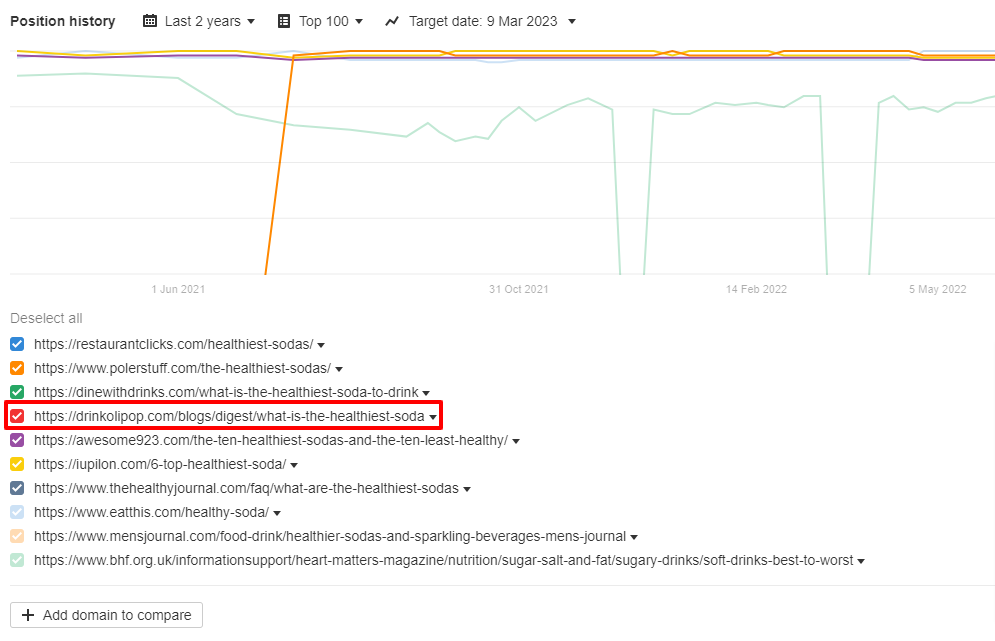 OLIPOP has written a blog around what constitutes a “healthy soda.” Within this blog, there is a healthy sprinkle of keywords throughout the piece. It’s important to try to fit in your keywords in the most natural way possible. Otherwise, keyword stuffing is easily detectable by Google and your page won’t rank.
OLIPOP has written a blog around what constitutes a “healthy soda.” Within this blog, there is a healthy sprinkle of keywords throughout the piece. It’s important to try to fit in your keywords in the most natural way possible. Otherwise, keyword stuffing is easily detectable by Google and your page won’t rank.
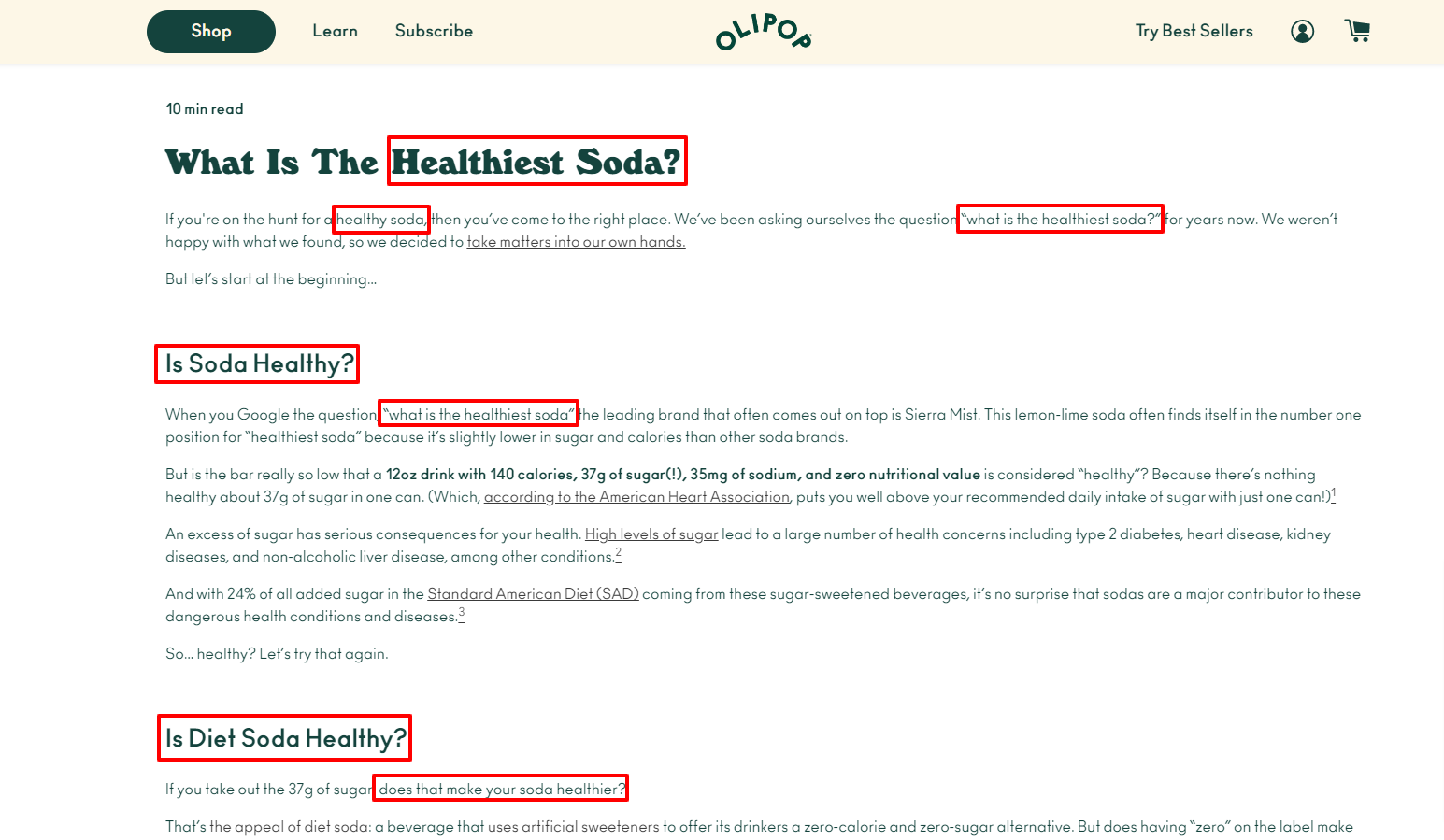 Instead, try to weave target and related keywords into a natural flow of content.
Instead, try to weave target and related keywords into a natural flow of content.
It’s always better to write for humans, then optimize for robots.
Meta Description
As the name suggests, it’s a short description ranging from 140–160 characters that give you an idea of what you’ll find before clicking on a link.
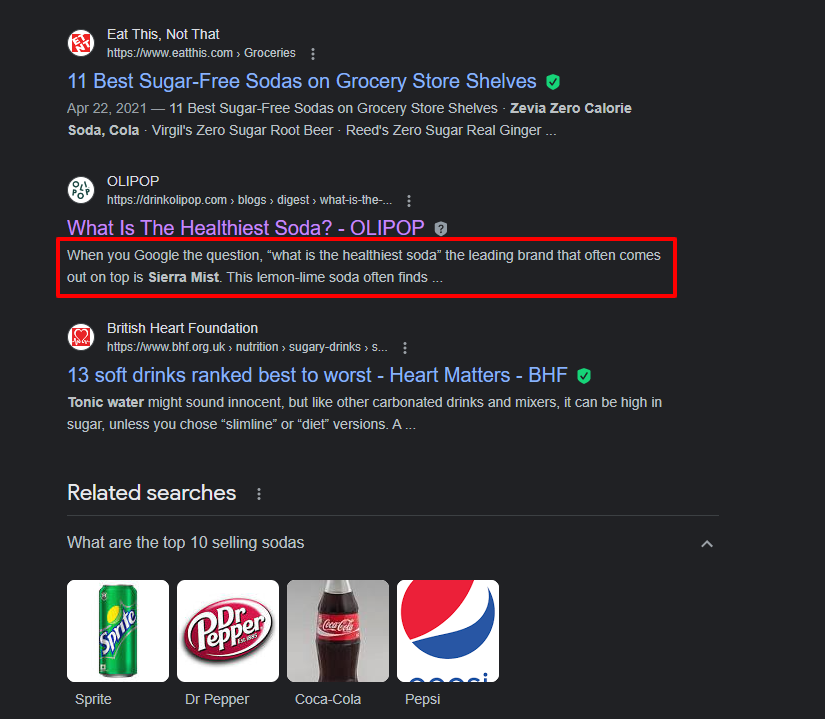 When you search for “what is the healthiest soda?” you find OLIPOP on the front page. We can see that OLIPOP has their target keyword in their meta description and title. These serve to not only tell Google that their page is about this subject, but it helps give the reader a preview into what the article is about.
When you search for “what is the healthiest soda?” you find OLIPOP on the front page. We can see that OLIPOP has their target keyword in their meta description and title. These serve to not only tell Google that their page is about this subject, but it helps give the reader a preview into what the article is about.
Alt Text
Sometimes, things break. It’s awful when it happens — and we do everything we can to prevent it, but we’re only human.
However, when things break, it’s a good idea to have a contingency plan in place. You can think of alt text this way. Alt text is a tiny snippet you add to the HTML code of an image that is meant to appear in case your image doesn’t load properly.
While this is great in terms of accessibility, it’s also fantastic for SEO.
Consider this: Google’s spiders are great at crawling text, right?
Well how does Google know which images to include in Google Image Search?
The answer is in the alt text and name of the image. By placing relevant keywords into your alt text, you can help tell Google how they should index an image.
And it’s a really simple add to your images.
Typically, in HTML, your code for an image might look like this:
This code basically explains the exact address of your image. Even if you use a CMS (content management system) like WordPress or HubSpot, every image you upload will have a unique address. If you’re using a CMS, there’s usually a field where you can input the alt text without having to touch the HTML.
All you have to do from that point is add in the alt text within that address.
<img src=”https://www.drip.com/hs-fs/hubfs/channel_marketing-BLOG.png?width=600&height=315&name=channel_marketing-BLOG.png” alt=”channel-marketing”>
In fact, we can see a clear example of this going back to OLIPOP’s product page.
 They’ve listed their alt text as “Ginger Lemon OLIPOP,” which tells Google not only which flavor it is, but also which brand it comes from.
They’ve listed their alt text as “Ginger Lemon OLIPOP,” which tells Google not only which flavor it is, but also which brand it comes from.
So naturally, if I Google “ginger lemon OLIPOP,” they’re the first result in Google Image Search:
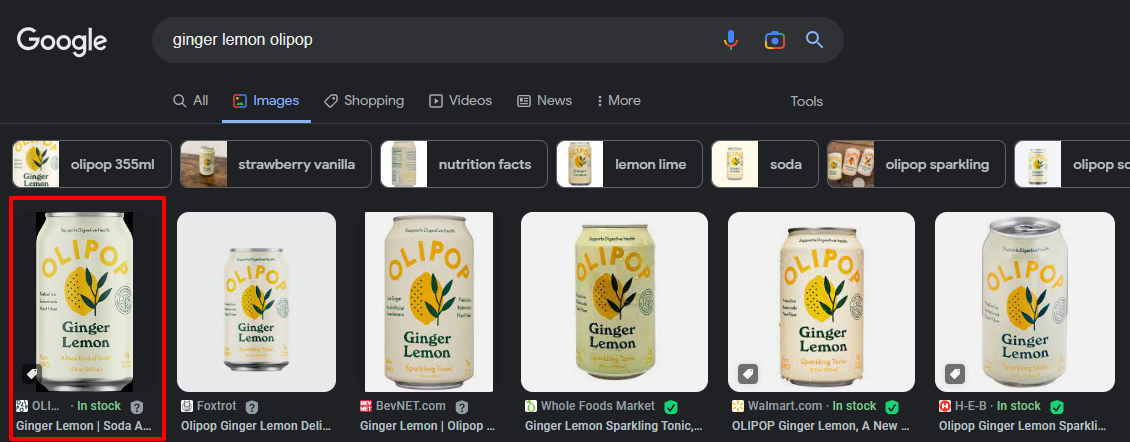 These are just a few examples of what good SEO practices can do for your ecommerce store.
These are just a few examples of what good SEO practices can do for your ecommerce store.
As they say, the devil is in the details.
Social Media Marketing
Social media is a huge frontier for ecommerce brands.
But where do you start?
Simply publishing product photos with a link back to the product page isn’t going to cut it — not in noisy social feeds anyway.
So here are a few ways to stand out:
Leverage Influencer Marketing:
You can harness the power of paid advertisements via influencers or social media companies like Meta and Twitter.
Influencers are social media accounts with massive followings that can get customers to visit your store.
Working with a great influencer that well-reflects your brand values and target niche can help you get the word out. If you choose an influencer wisely, their audience will be kind of like a lookalike audience to yours, helping you target more would-be customers.
Beware: It’s not always the biggest influencers you want to contact. Sometimes smaller, more tight-knit communities are the way to go if you want a great influencer marketing campaign.
Running Targeted Ads:
Social media platforms like Facebook, Instagram, and Twitter also run targeted ads you can use that are guaranteed to bring you results.
However, the trick to mastering paid advertisements is ensuring you’re targeting the right market. You can research or hire a social media manager to help you with this.
Much like with organic social media, you need to only target social platforms where your customers are and why they’re on that platform.
For example, if you’re marketing clothing and apparel to millennials, you might choose Instagram over LinkedIn. Even though many millennials are on LinkedIn, that platform doesn’t make sense for clothing and apparel, as opposed to the visually-stimulating Instagram, which is perfect.
However, if you were selling work-from-home office furniture, LinkedIn might be the perfect place to do that.
Running targeted ads is about what makes sense for your customers.
Creating Video Content:
The form of content you post on social media also determines how far your content goes.
For instance, if you post video content, Hubspot says keeping them within 60 seconds will improve its effectiveness.
Your short videos can be funny clips relating to customer pain points. Alternatively, you can create informative videos teaching your potential customer about alleviating those pain points.
Even better, you could do both.
You can also harness your customer's content and post reviews on your page.
A good example is the skincare brand Rhodes’ Instagram post.
In this post, Rhodes shows off customer testimonials after using their product, and you can swipe to the left to view more.
Customers love reviews because they tell them all they need to know about a product before making a purchase.
Using the Right Hashtags:
Finally, don’t forget to use hashtags when posting on social media.
Hashtags work a lot like keywords; if you add relevant hashtags to your posts, they’ll appear on any user’s feed following that hashtag.
Customers also tend to search for posts via a hashtag. This is a great way to get in front of the eyeballs that want to see your content.
Be careful though: it’s important to curate exactly how many hashtags you actually use.
As a rule of thumb:
- Twitter: 1-2 hashtags maximum
- LinkedIn: 1-3 hashtags maximum
- Instagram: Go crazy. You can have as many as you want.
- TikTok: Go nuts. Just stay under the caption character limit.

Inbound Marketing: What’s Next?
Inbound marketing is far from a new strategy. Instead, it’s considered a core fundamental for you to get as many people to your store as possible.
The great part is that when you work at inbound marketing, it essentially helps you attract new eyes on autopilot.
It’s like having a salesperson that works 24/7/365.
But what do you do once all those new eyes come to your site?
Sure, inbound marketing can help you convert and close some of them. But what about the others who need a little help getting down the sales funnel?
This is where Drip comes in. A well-timed popup can help you qualify those new visitors to your ecommerce site and get them to the next step. Getting them to sign up for your email list with a nice incentive or free shipping is a great way to get yet another opportunity to delight them.
From there? A nurturing welcome automation flow and you’re converting more than you’d have done relying on inbound alone.
But don’t take my word for it. Try Drip free for 14 days and test what it could add to your inbound marketing strategy.
